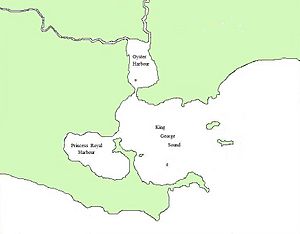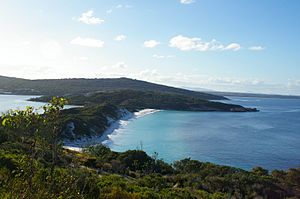King George Sound (Western Australia) facts for kids
King George Sound is a large bay found on the southern coast of Western Australia. It was first called King George the Third's Sound. Later, people started calling it King George's Sound around 1805. The name "King George Sound" became common after 1934. This happened because new maps from the British Navy wanted to remove the 's' from place names.
The sound covers a huge area of 110 square kilometres (42 sq mi). Its depth changes from 10 metres (33 ft) to 35 metres (115 ft). The city of Albany is located right here.
The mainland is to the north of the sound. Vancouver Peninsula is on the west side. Bald Head and Flinders Peninsula are to the south. Even though the sound is open to the east, Breaksea Island and Michaelmas Island help protect its waters.
Inside the sound, there are two safe harbours. Princess Royal Harbour is to the west. Oyster Harbour is to the north. Both are very safe from strong winds and big waves. For about 70 years, Princess Royal Harbour was Western Australia's only deep-water port. This was until the Fremantle Inner Harbour opened in 1897.
Contents
Exploring King George Sound
The first European to visit King George Sound was Captain George Vancouver in 1791. He was an English explorer. He named it King George the Third's Sound after the king at that time.
Later, in 1801, Matthew Flinders anchored in the sound. He stayed from December to January 1802 and explored the area. During his visit, his team found a copper plate left by earlier whalers. The ship's botanist, Robert Brown, collected over 500 types of plants.
In 1803, Nicolas Baudin arrived in the sound. He was a French explorer. His ship's naturalist, François Péron, found many new types of shellfish and starfish.
Other explorers also visited. Phillip Parker King came in 1818. Frenchman Jules Dumont d'Urville visited in 1826.
The Settlement of Albany
On December 25, 1826, a ship called Amity arrived at King George Sound. Major Edmund Lockyer was in charge. They came to start a military settlement. Lockyer named it Fredrick Town. This was after Prince Frederick, the king's second son. However, people mostly kept calling the area King George's Sound.
In 1832, Governor James Stirling officially named the settlement Albany. But the wider area was still called King George's Sound for many years.
In 1836, the famous ship HMS Beagle visited King George Sound. The young naturalist Charles Darwin was on board. He collected many plant and animal samples on shore.
A Key Port
Until 1897, King George Sound had Western Australia's only deep-water port. This made it a very important place. Mail and supplies from other countries arrived here first. They were then sent to Perth and Fremantle by road or smaller ships. Later, the Great Southern Railway made transport much faster.
Today, the Albany Port is still busy. It is on the north shore of Princess Royal Harbour. The port can handle large ships. About 120 ships visit the port each year.
ANZAC History
In 1914, King George Sound was the last stop in Australia for a large fleet of ships. These ships were carrying the first Australian and New Zealand soldiers to Egypt. These soldiers later became known as the Anzacs.
A special memorial for the Anzacs is on top of Mount Clarence. The very first Anzac Day dawn service was held in Albany on April 25, 1923. The entrance to Princess Royal Harbour is named Atatürk Entrance. This honours Mustafa Kemal Atatürk, who was the president of Turkey.
Whaling and Protection
In the past, whaling was a big industry here. The Cheyne Beach Whaling Company started operating in Frenchman Bay in 1952. They hunted humpback whales and sperm whales. At its busiest, the company caught between 900 and 1100 whales a year.
However, hunting humpback whales was banned in 1963. This made the company less profitable. In 1978, the Cheynes Beach Whaling Company closed down. This was due to pressure from environmental groups. It was the last coastal whaling company in Australia.
In 2016, a shark barrier was put in place at Middleton Beach. This helps keep swimmers safe.
Plants of the Sound
King George Sound has many thick beds of seagrass. These plants are important for marine life. Some types of seagrass found here include Posidonia australis and Amphibolis antarctica.
Around the edges of the sound, you can find different plants. There are saltmarshes with plants like samphire and saltwater paperbark. Sandy beach areas have shrubs and sedges, such as the grey white cushion bush.
Animals of the Sound
The sound is home to a huge variety of marine animals. This is because it has many different habitats.
Marine Life
Many types of coral grow here. These include Turbinaria frondens and Scolymia australis. There is also a large wild population of mussels. Now, commercial mussel farms also operate in the area, growing Blue mussels.
It is thought that 203 different kinds of fish live in the sound. Pilchards make up most of the fish caught. Other common fish include Australian herring, King George whiting, and Australian salmon.
Seals and Dolphins
Seals live in various spots along the coast and on the islands. The Australian sea lion and the New Zealand fur seal are seen most often. Sometimes, other seals like the leopard seal visit.
Dolphins are also found here. The common dolphin and the bottlenose dolphin have been seen in the area.
Whales
Southern right whales and humpback whales come to the sound between July and October. They gather in the protected waters to mate and have their calves. Other whales like minke whales and blue whales have also been spotted. Sperm whales used to visit during whaling times.
Birds
In summer, the sound becomes a perfect home for many migratory wading birds. About 2,000 to 3,000 birds come to feed in the shallow mudflats. Some of these birds are the red-necked stint and the red knot. Other birds commonly seen include cormorants, pelicans, and white-bellied sea eagles.
Land and Islands
The south coast of Western Australia has strong headlands made of granite. These rocks were formed a very long time ago. Between these headlands are curved bays with sandy beaches.
King George Sound has many islands and small islets. Most of them are made of granite rocks and have some soil. Important islands include Breaksea Island, Michaelmas Island, Seal Island, Mistaken Island, and Green Island.
Water Conditions
The tide in King George Sound does not change much. The normal tidal range is 0.4 metres (1.3 ft). Sometimes, the water level can stay the same for a while.
The water temperature in the sound is a bit different from the open sea.
| Location | Average Summer Temp (°C) | Average Winter Temp (°C) |
|---|---|---|
| Open sea | 20.1 | 17.3 |
| King George Sound | 20.5 | 13.6 |
The saltiness of the water stays fairly steady. It ranges between 34.8 and 35.5 parts per thousand. It gets less salty during heavy winter rains. This is when a lot of fresh water flows into the sound from the King and Kalgan rivers.
The Leeuwin Current also affects the sound. This current flows eastwards along the edge of the land.
Shipwrecks in the Sound
Many shipwrecks can be found in King George Sound. The most well-known recent wreck is the HMAS Perth. This 133-metre (436 ft) guided missile destroyer was sunk on purpose in 2001. It lies in 35 metres (115 ft) of water near Seal Island. It is now a popular place for divers to explore.
The former whale hunting ship Cheynes was sunk between Michaelmas Island and the northern shore. Another whale ship, Cheynes II, ran aground in 1990 and is still there.
Other wrecks include the Lady Lyttleton, which sank in 1867. The Fanny Nicholson and Runnymede, both whaling ships, ran ashore during storms in the 1870s and 1880s.
Two wrecks, the Athena (sank 1908) and the Elvie (sank 1923), are protected by law. This means they are important historical sites.
In 1868, the ship Northumberland hit a reef near the entrance to King George Sound. The crew had to leave the ship. It then sank between Cape Vancouver and Breaksea Island.
Images for kids
-
Phillip Parker King's 1818 sketch of Oyster Harbour
-
King George's Sound, view from the north-west, by William Westall in 1801





















